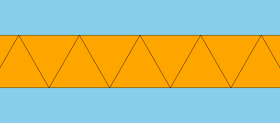Apeirogonal_antiprism
Apeirogonal antiprism
Antiprism with an infinite-sided polygon base
In geometry, an apeirogonal antiprism or infinite antiprism[1] is the arithmetic limit of the family of antiprisms; it can be considered an infinite polyhedron or a tiling of the plane.
If the sides are equilateral triangles, it is a uniform tiling. In general, it can have two sets of alternating congruent isosceles triangles, surrounded by two half-planes.
 ...
...







